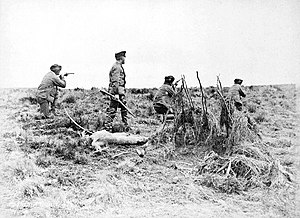
Back إبادة السالكنام الجماعية Arabic Saneaytara va Selknam AVK Genocidi selknam Catalan Misión Salesiana (Río Grande) Spanish Selknam genozidioa Basque Extermination des Selknam French Xenocidio selk'nam Galician Genocídio Selk'nam Portuguese Геноцид селькнамов Russian Selk'nam Soykırımı Turkish
You can help expand this article with text translated from the corresponding article in Spanish. (July 2019) Click [show] for important translation instructions.
|
| Selk'nam genocide | |
|---|---|
| Part of Genocide of indigenous peoples | |
 Julius Popper and his men standing next to an unclothed dead Selk'nam (1886) | |
| Location | Tierra del Fuego, Argentina and Chile |
| Date | Late 19th to early 20th century |
Attack type | Genocidal massacre, internment, bounty killings |
| Deaths | Unknown; population decline from c. 4,000 around 1850 to c. 100 in 1930[1] |
| Victims | Selk'nam tribe |
| Perpetrators | European and South American hunters, ranchers, gold miners, and soldiers[2] |
| Motive | Utilitarian genocide |
| Part of a series on |
| Genocide |
|---|
 |
| Issues |
| 15th–19th century genocides |
| Early 20th century genocides |
| World War II (1939–1945) |
| Cold War (1940s–1991) |
| Contemporary genocides |
| Related topics |
|
| Category |
| Part of a series on |
| Genocide of Indigenous peoples |
|---|
| Issues |
The Selk'nam genocide was the systematic extermination of the Selk'nam people, one of the four indigenous peoples of Tierra del Fuego, in the late 19th and early 20th centuries.[3][4] Historians estimate that the genocide spanned a period of between ten and twenty years, and resulted in the decline of the Selk'nam population from approximately 4,000 people during the 1880s to a few hundred by the early 1900s.[5][6]
During the late 19th century, European and South American livestock companies affiliated with the Chilean and Argentinian governments began to establish estancias (large ranches) on the Isla Grande de Tierra del Fuego, which along with the Tierra del Fuego gold rush displaced the indigenous population and heavily disrupted their traditional way of life.[7] In response to violence between non-indigenous settlers and indigenous people, a campaign was conducted by European and South American hunters, ranchers, gold miners and soldiers to exterminate the Selk'nam.[8][9]
Livestock companies paid their employees and third-party hunters such as Julius Popper to kill or capture Selk'nam people. The Chilean and Argentine military were also involved in the genocide, carrying out attacks on the Selk'nam during exploratory voyages. Selk'nam people living on the northern part of the island were the first to be affected by this violence, which prompted them to migrate southwards towards forested areas of the island unsuitable for livestock grazing. Eventually, the Chilean and Argentine governments issued land grants to the Salesians of Don Bosco, allowing them to establish several Christian missions to "save" the remaining Selk'nam, who were deported to Dawson Island. By 1930, only 100 Selk'nam were still alive.[6]
- ^ Cite error: The named reference
Gardiniwas invoked but never defined (see the help page). - ^ Adhikari, Mohamed; Carmichael, Cathie; Jones, Adam; Kapila, Shruti; Naimark, Norman; Weitz, Eric D. (2018). "Genocide and Global and/or World History: Reflections". Journal of Genocide Research. 20 (1): 134–153. doi:10.1080/14623528.2017.1363476. S2CID 80081680.
- ^ Gigoux 2022, pp. 1–2.
- ^ Harambour 2019a, p. ?.
- ^ Harambour 2019a, p. 13.
- ^ a b Chapman 2010, p. 544.
- ^ Harambour, Alberto (2016). "Sheep Sovereignties: The Colonization of the Falkland Islands/Malvinas, Patagonia, and Tierra del Fuego, 1830s–1910s". In Beezley, William (ed.). Oxford Research Encyclopedia of Latin American History. Oxford University Press. doi:10.1093/acrefore/9780199366439.013.351. ISBN 978-0-19-936643-9.
- ^ Odone, Carolina; Palma, M. "La muerte exhibida fotografias de Julius Popper en Tierra del Fuego" [The death exhibited photographs of Julius Popper in Tierra del Fuego]. In Mason, Peter; Odone, Carolina (eds.). 12 Miradas: Ensayos sobre los pueblos patagonicos [12 Looks: Essays on the Patagonian peoples]. Culturas de Patagonia (in Spanish)., cited in Mason, Peter (2002). The Lives of Images. Reaktion Books. p. 153. ISBN 9781861891143.
- ^ Ray 2007, p. 80.
© MMXXIII Rich X Search. We shall prevail. All rights reserved. Rich X Search